The river season may have just ended but June will soon be here and in my book it’s never too early to start planning your river assault in readiness for the next opening day. One of my last river sessions of the season just gone was simply incredible and if my telling of it doesn’t whet your appetite for the coming season then nothing will!
My approach for the session was going to be the feeder and to catch more barbel with feeder tactics an angler needs to have a strategy and there are numerous changes that can be made when feeder fishing. Some of these changes are subtle, some are more extreme but having options in place, coupled with the ability to react to changing conditions, makes feeder fishing much less of a ‘chuck it and chance it’ method and certainly helps to put more fish on the bank.
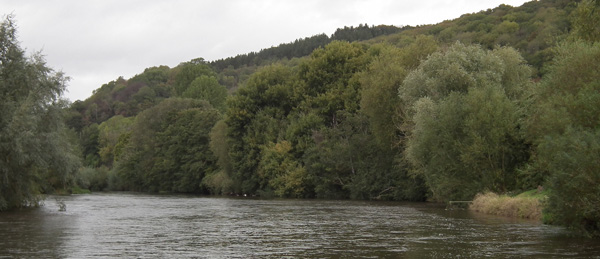
Today I’ve come to a peg on the Holme Lacy stretch of the River Wye. The river is carrying a couple of feet of extra water and is fining down but still quite coloured and pacey. It looks just right for a bold approach and the sort of river I can set about attacking. To me barbel fishing at this time of year is all about impact and I like to impose myself on a peg and give any fish in the area a reason to come looking straight away as opposed to waiting for them to turn up.
Traditionally block-end feeders were the only way forward for barbel but the revolution of halibut-based products has opened up a whole range of possibilities with regards to bait and how it’s fed. The idea of using groundbait for barbel was disregarded for many years but now halibut groundbait is my absolute first choice on big rivers at this time of year.
Starting off on a big cage feeder allows me to deliver a lot of particles as well as creating a trail of groundbait into my swim. I’ve always got the option to change to a block-end feeder at any time and I can do this in conjunction with any combination of the super seed particles I’ve incorporated in my groundbait. This is a massive part of the plan that I have developed for pegs like this. I will fine things down in colder weather, and possibly go down the smaller, maggot/block-end feeder route, but at this time of year I can be bold and really go for it.
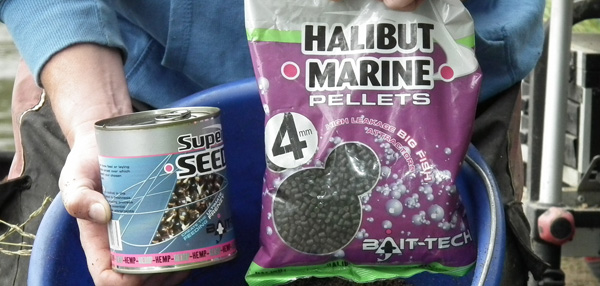
I cannot express enough the importance of having gear that is up to the job and making sure everything is in working order. These barbel fight harder than any other river fish and the power they possess, as well as their size, means they are equipped to reek havoc on an undergunned angler; everything has to work like a well-oiled machine.
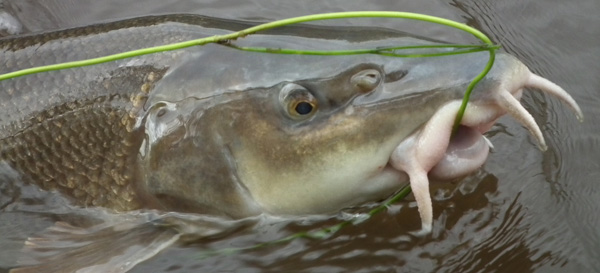
Firstly, the rods have to be capable of casting a heavy feeder with anything up to 6oz of lead attached and it has to be long enough to keep as much line out of the water as possible to keep the feeder in place in heavy flows. It then needs power through the middle to be able to move the feeder through the water quickly on the retrieve or to tame any angry barbel into submission. The action is most important when a fish is under the rod tip as it needs the power to lift these bottom-hugging fish to the surface, whilst still maintaining some action to counteract their lunges.
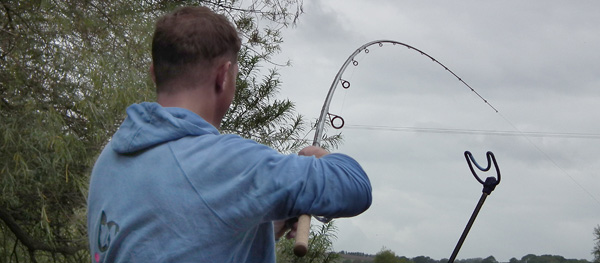
My favourite rod for this type of fishing is the 13ft 6in Tri-Cast Trilogy X Power; this rod has the essential qualities for this style of fishing, not only here on the Wye, but also rivers like the Severn or parts of the Trent.
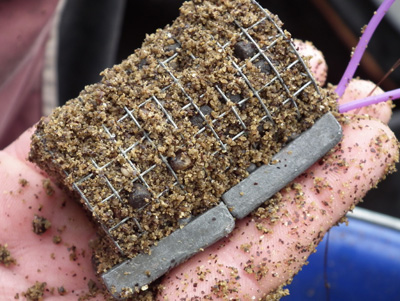 I couple my rod with Daiwa Excellor Plus reels in a 4000 size. Reels in these circumstances have to be just as powerful as the rods as constantly winding in lumps of lead puts enormous strain on the gearing and poor quality reels soon just fall apart under the pressure. I have three spools for each reel loaded with 6, 8 and 10lb Maxima and this covers all of the situations I face when feeder fishing for barbel. Maxima is such a durable line and stands up to the considerable stress caused by big feeder fishing; today I am using 8lb breaking strain.
I couple my rod with Daiwa Excellor Plus reels in a 4000 size. Reels in these circumstances have to be just as powerful as the rods as constantly winding in lumps of lead puts enormous strain on the gearing and poor quality reels soon just fall apart under the pressure. I have three spools for each reel loaded with 6, 8 and 10lb Maxima and this covers all of the situations I face when feeder fishing for barbel. Maxima is such a durable line and stands up to the considerable stress caused by big feeder fishing; today I am using 8lb breaking strain.
I carry an array of feeders with me and multiples of the same size. My block-end feeders are all Kamasan Black caps which are very tough and never crack or let me down. I also carry a lot of cage and open end feeders of all shapes and sizes. It is important to carry plenty of spares as some pegs are very snaggy. Over the course of a session I get to know where the snags are and am usually able to navigate my way around them but it sometimes takes a few lost feeders to do this.

When casting I always like to trap my finger against the spool as the feeder hits the water; I then watch the rod tip and lower it forward as the feeder sinks. You can really feel the feeder hit the bottom and it’s the feel of this landing that tells me whether it’s settled on gravel, silt or even in a snag. There’s something very reassuring about a feeder hitting gravel with a definite bump!
I also carry a box full of clip on leads to change the feeder weight to counteract changing flows and this is where there is a real art to feeder fishing. I always like to fish with a bow in my line which allows less weight to be used, but if the river is rising or flowing fast I want to nail the bait down and I use as much lead as is needed to achieve this comfortably.
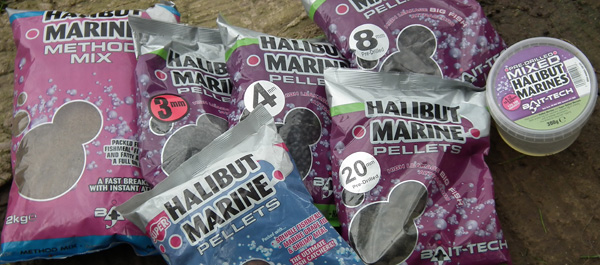
For hooklengths, whatever hook pattern I choose, I use Preston Power in 0.21mm diameter and I rarely drop below a 0.19mm diameter when barbel fishing. I won’t compromise on line strength and in my opinion it’s just not worth the risk of losing fish. I carry a couple of hooklength boxes containing hair rigs and big spade end hooklengths. I’m not too bothered about spade end hooklengths as these can be tied on the bank quite quickly between casts but hair rigs are a little more intricate and I like to have a good stock ready-tied. The hooks I use for maggot and caster are Kamasan Animal Spades and for hair rigs I use Korum S3 seamless; both patterns offer unbelievable strength and sharpness and have never let me down.
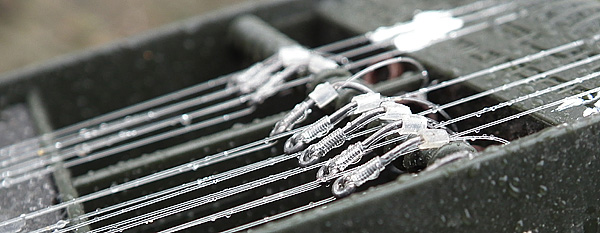
Apart from the terminal tackle everything else has to set up correctly. Casting can be tricky with big feeders so the position of my seatbox and everything around me has to be in order. The rod rest has to be in the right position too and I like to keep the rod high to keep as much line out of the water as possible, but I don’t want to be straining my neck all day so the angle has to be set just right. I like the rod facing downstream directly at where the line is entering the water this way, when I strike, I’m lifting straight into the bow of line which puts me straight in contact with the feeder and the hooked fish.
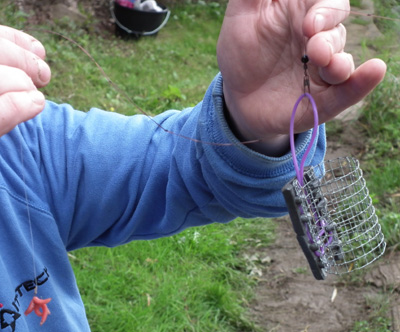 The rig I use for most of my feeder fishing is a multiple loop rig. This consists of a feeder being tied into a loop of about 12 inches. The tag end is trimmed and the feeder is then slid back up to the knot.
The rig I use for most of my feeder fishing is a multiple loop rig. This consists of a feeder being tied into a loop of about 12 inches. The tag end is trimmed and the feeder is then slid back up to the knot.
A figure of eight knot is then tied below the feeder so that the feeder is running up and down a 3 inch loop. I always attach a Korum feedabead to the feeder before tying the loop as this allows the quick interchange of feeders or leads.
A series of knots is then tied down the remainder of the loop leaving a 2 inch loop for the hooklength to be attached to. This series of knots helps to create a ‘stiff link’ which keeps the hooklength away from the feeder.
Big feeders (especially with added lead) have a tendency to rub against the main line and hooklength which can cause them to weaken. The way barbel violently shake their heads adds to this wear and tear so I find the double length of line that the feeder runs on takes the punishment well and also stops the hooklength from deteriorating.
In reality the rig is a bolt rig but the 3 inch loop is vital because if the feeder does become trapped in a snag and doesn’t move when the fish swims away, I still get some indication on the rod tip. This gives me a chance to strike and hopefully dislodge the feeder. Without this there would be no indication of a bite and the first I’d know of it would be when I wound in minus a hooklength.
Normal uninhibited bites will usually result in a sharp drop back on the tip. If I was fishing under my feet or on the inside third of the river I would probably revert to using a simple running rig with the feeder stopped against a buffer bead swivel to which I would attach my hooklength. This would be my choice of rig for narrower rivers as well.
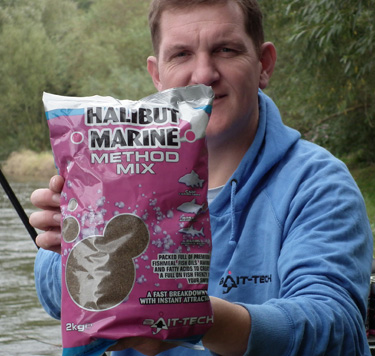 I’m starting today with a cage feeder containing neat Bait-Tech Marine Halibut Method Mix groundbait. This groundbait can be bulked out with crumb but, as I said earlier, I like to make an instant impact. Rich, flavourful, groundbait containing hemp and 4mm halibut pellets, delivers a parcel of goodies and attractants that should pull fish from all around.
I’m starting today with a cage feeder containing neat Bait-Tech Marine Halibut Method Mix groundbait. This groundbait can be bulked out with crumb but, as I said earlier, I like to make an instant impact. Rich, flavourful, groundbait containing hemp and 4mm halibut pellets, delivers a parcel of goodies and attractants that should pull fish from all around.
My starting hookbait is always maggot: five reds on a size 12 to be precise, which may sound extreme but when compared to the coloured water and heavy feeder it is a perfect bait to kick off with and I have lost count of the amount of fish I’ve caught first chuck on this combination.
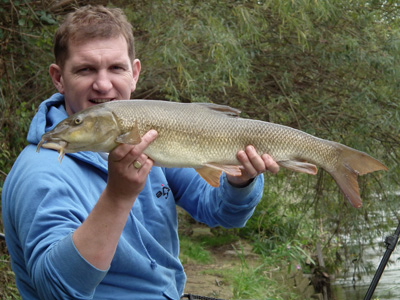 It really is amazing how often I get an early response and even if it’s a small fish it gives me a chance to get more feed into the peg. Today is no different as a lovely slender barbel is landed within five minutes; next cast and I hook and land a bigger barbel of about 6lb.
It really is amazing how often I get an early response and even if it’s a small fish it gives me a chance to get more feed into the peg. Today is no different as a lovely slender barbel is landed within five minutes; next cast and I hook and land a bigger barbel of about 6lb.
As is so often the case with this method I have had regular bites for the first couple of hours. I’ve tried putting a longer hooklength on to see if any barbel are sitting back off the feed but this just results in small dace and minnows shredding the maggots every time.
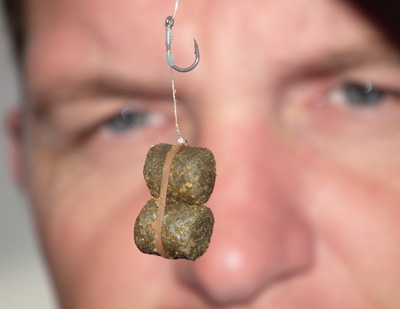 At this stage it’s time for the first major change of the day and I attach a hair rig. My hair rigs are all tied with a pellet band attached as I find this a versatile way of hair rigging. I can band a single or double pellet, pull the band through a piece of meat or through a couple of drilled pellets with a bait stop to hide the band. I also tie the hairs quite long as these days I almost always wrap the hookbait in paste as an added attractor.
At this stage it’s time for the first major change of the day and I attach a hair rig. My hair rigs are all tied with a pellet band attached as I find this a versatile way of hair rigging. I can band a single or double pellet, pull the band through a piece of meat or through a couple of drilled pellets with a bait stop to hide the band. I also tie the hairs quite long as these days I almost always wrap the hookbait in paste as an added attractor.
Changing to a large blockend feeder, still in conjunction with the hair rig, I simply fill the feeder with 4mm Halibut Marine pellets and mount a paste wrapped 10mm pellet on the band; I also add a bit of extra weight to the feeder as I don’t want this to move at all in the current.
By feeding just pellets in the feeder I’m actually feeding a lot less than before but for some reason it nearly always sparks a response form barbel, even in flood conditions. It may be that after a while they become wary of the big cage feeder and sit back a bit but, as in previous sessions, the barbel do come out to play again and I have a nice run of fish to about 8lb.
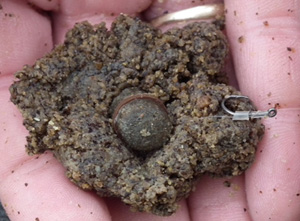
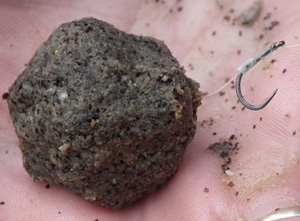
I’m positive that the paste is a key element. I mix my paste using the same groundbait as my feeder mix but I make it up using an egg and a little halibut oil. This not only binds the paste well and keeps it secure through the casting process, but also produces a paste that breaks down quickly and sends a trail of smell and particles downstream from the hookbait. In faster currents I stiffen it up to slow the breakdown. I find it a deadly addition to a pellet hookbait and a proper impact bait and it is very rare that I cast out a pellet these days without a paste wrap.
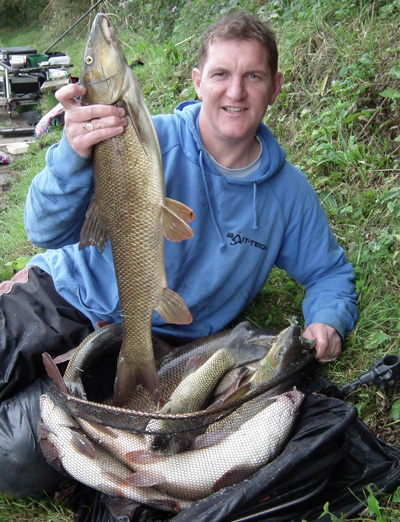 I end the session with ten barbel and a chub for about 60lb. By ringing the changes in a structured but reactive way I’ve managed to keep bites coming all through the session.
I end the session with ten barbel and a chub for about 60lb. By ringing the changes in a structured but reactive way I’ve managed to keep bites coming all through the session.
At no point today have I felt that there was nothing to do but sit and wait and I’m not sure I would have had such an instant response on just a pellet feeder. Fishing with maggot or hemp and caster in a blockend feeder may have seen me pestered by small fish but they were all things that I could have tried had the bites dried completely.
It’s good to break a session down into half hour segments when you’re searching for your next bite. This keeps it interesting and fills the gaps in a proactive way; it’s never a hopeless cause and there is always something to try!











